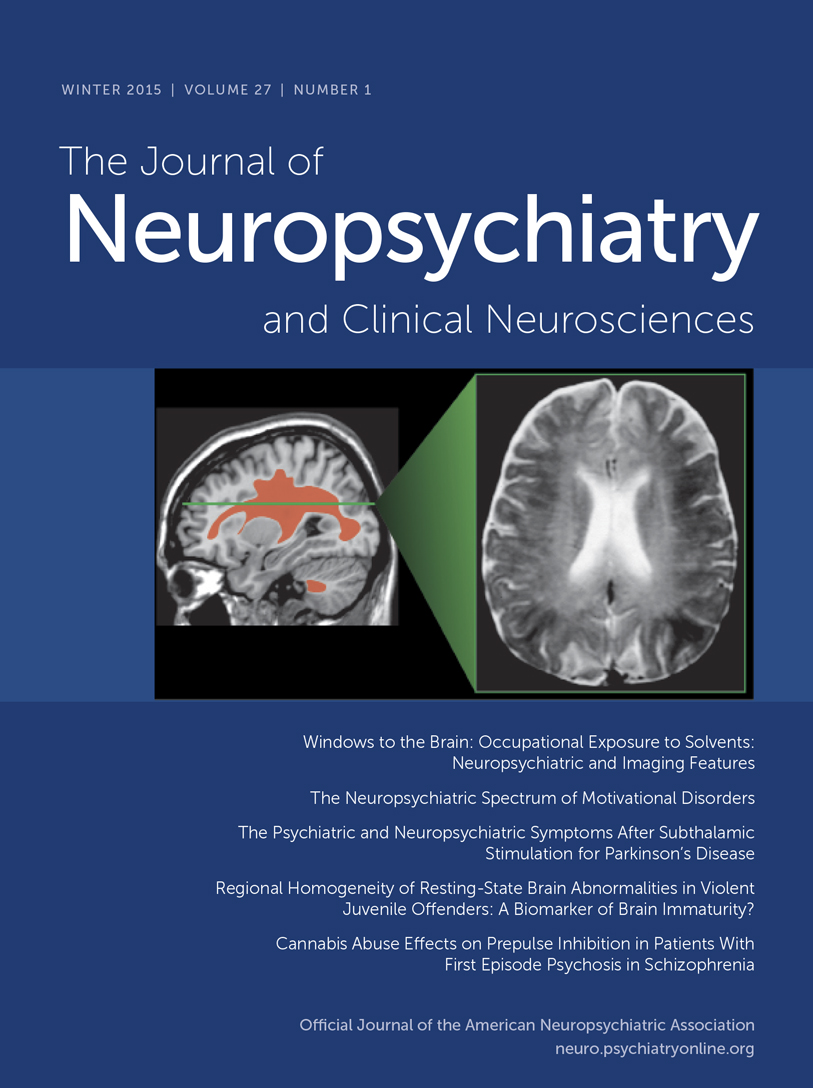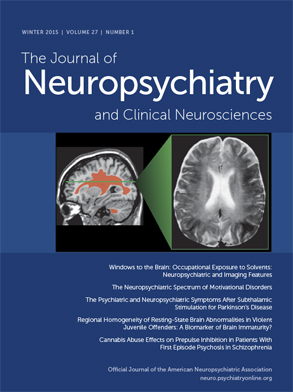Wilson’s disease is a rare autosomal recessive condition involving abnormal copper accumulation in the body due to a defect in the ATP7B gene, which encodes a membrane bound copper binding protein.
1 It presents with hepatic, neurological, and behavioral manifestations. About 20% of patients initially present with behavioral symptoms.
2 Personality change, “incongruous behavior,” cognitive impairment, and depression are commonly reported.
3 Although depression is common, mania has also been reported.
4 Psychotic phenomena and catatonia are rare.
5–7 We report a patient who presented with acute psychosis that remitted with treatment. This was followed by onset of catatonia and was later diagnosed as Wilson’s disease. This case is discussed from the psychiatrist’s perspective.
Case Report
“Ms. S,” a 19-year-old woman, born out of a nonconsanguineous marriage, with no past or family history of physical or psychiatric illness presented to us with abrupt onset of suspiciousness, fearfulness, impaired biological functions, irrelevant talk, and disinhibited behavior following high-grade fever of an ∼1-week duration without chills/rigor or any localizing sign. She was started on risperidone, and when she presented to us after 2 weeks of onset of symptoms, she was on 6 mg risperidone. When she presented to us, she was uncooperative, apathetic, and had poverty of speech, psychomotor retardation, and posturing. Neurological examination revealed no abnormalities except rigidity in the limbs. She was provisionally diagnosed to have an acute and transient psychotic disorder with drug-induced extrapyramidal symptoms, and a differential diagnosis of organic catatonia was considered. A complete hemogram, chest X-ray, renal function, liver function, thyroid profile, urine, blood culture, and EEG did not reveal abnormalities. She tested negative for dengue, malaria, and typhoid. Risperidone was cross-tapered with olanzapine up to 20 mg/day. Her symptoms significantly improved in a month and she was discharged.
Then after 2–3 months, she gradually developed slowness in activities of daily living, a decrease in speech output, stiffness in the limbs, loss of emotional reactivity, and social withdrawal. She had severe psychomotor retardation, staring, grimacing, and posturing. A provisional diagnosis of catatonic schizophrenia with drug-induced extrapyramidal symptoms was considered. There was no improvement after adding trihexyphenidyl up to 6 mg/day. Therefore, her medications were changed from olanzapine (up to 25 mg/day) to aripiprazole (up to 20 mg/day) and subsequently to quetiapine (up to 600 mg/day) over the next 6 months without significant improvement. Each medicine was given a trial ranging from 6 weeks to 2 months. She was referred to a neurologist who advised copper studies and ophthalmological evaluation to rule out a Kayser–Fleischer ring. However, her family could not afford the studies because of economic constraints and she dropped out of treatment for about 1 year. The family had stopped all medicines and took her for faith healing. During this time, her condition had further worsened. Because she was off the medications, drug-induced causes were ruled out.
When she presented to us after a year, she was bedridden, mute, immobile, and on a liquid diet for 6 months. She could only gesture to parents about food intake and bladder and bowel functions. There was no history of prolonged high-grade fever, seizures, or trauma. No hallucinatory behavior was observed. She was conscious, and her Glasgow Coma Scale
8 was 10 (eye opening, spontaneous; verbal response, incomprehensible sounds; motor response, withdrawal to painful stimuli). Her vitals were stable. On the Bush Francis Catatonia Rating Scale,
9 she had immobility, mutism, staring, posturing, grimacing, rigidity, and negativism, with a total score of 13. Neurological examination revealed 4/5 power in all four limbs without any focal neurological signs. On a lorazepam challenge test with 2 mg of intravenous lorazepam, her Bush Francis Catatonia Rating Scale score decreased to 7. She was able to walk with support from her family members. There was no improvement in mutism, rigidity, and grimacing. She was started on oral lorazepam 4 mg/day in divided doses. Serum ceruloplasmin was very low, and 24-hour urinary copper was 87.5 mg/dL (reference range, <50 mg/dL). Opthalmologic evaluation revealed a bilateral Kayser–Fleischer ring. An abdominal ultrasound revealed coarse echotexture in the liver suggestive of chronic liver disease without portal hypertension or ascites. An MR image (brain) revealed bilateral T2 hyperintensity in different regions of the basal ganglia. Chronic liver disease was ruled out by viral markers and an autoimmune profile.
In consultation with the neurologist, she was diagnosed with Wilson’s disease and started on zinc acetate 50 mg and penicillamine 250 mg twice daily along with oral pyridoxine supplementation. Oral lorazepam 4 mg/day in divided doses was continued. She was able to perform activities of daily living with the help of family members. At the time of the last assessment, the Bush Francis Catatonia Rating Scale had decreased to 4. The family was advised to screen the other siblings.
Discussion
Our patient had several indicators toward organicity, such as acute onset febrile illness, catatonic features, and unusual sensitivity to extrapyramidal side effects with atypical antipsychotics. She initially presented with psychotic symptoms that improved with antipsychotics. Then she gradually developed negative symptoms, catatonic features, and rigidity, which were attributed to drug-induced side effects or worsening of the psychotic process. Her symptoms did not respond to adequate trials of three antipsychotics. Among drug-induced side effects, the possibility of neuroleptic malignant syndrome (NMS) was not considered due to the lack of other associated symptoms such as fever and autonomic instability. Because her symptoms progressed even when the medications were discontinued, mild NMS or drug-induced causes are unlikely to explain the clinical picture. The delay in diagnosis of Wilson’s disease and treatment resulted in severe dysfunction and disability, which could have been prevented.
Chelating agents are standard treatment for Wilson’s disease. Electroconvulsive therapy has been reported to be effective in some cases.
7 Potassium disulfide, ascorbic acid, and vitamin E have also been tried without proven efficacy.
10Routine screening for Wilson’s disease in patients less than 40 years of age with psychiatric manifestations has been recommended.
3 Dening and Berrios recommended that Wilson’s disease should be suspected in all psychiatric patients who show personality change (especially disinhibited, bizarre, or reckless behavior) and neurological signs unaccounted for by medications and have unexplained hepatic disease.
11 Recent guidelines recommend that Wilson’s disease should be ruled out in any patient with hepatic impairment, irrespective of severity, in combination with any neurological or neuropsychiatric manifestation.
12 Routine screening by an ophthalmological evaluation is also recommended for a Kayser–Fleischer ring in such patients. Although a Kayser–Fleischer ring is not universal in Wilson’s disease, it is present in 99% of patients with neuropsychiatric manifestations; hence, it may be a useful screening test.

